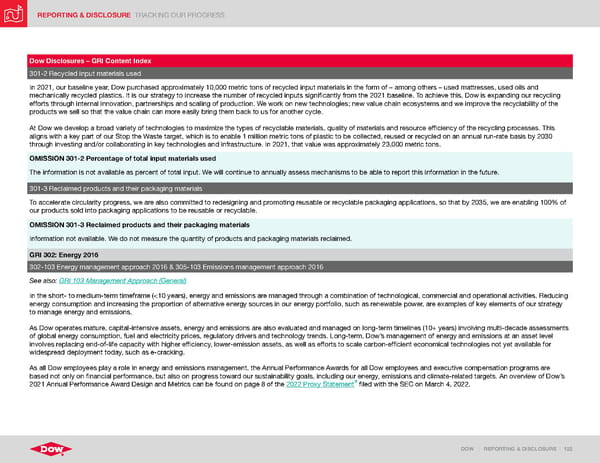REPORTING & DISCLOSURE TRACKING OUR PROGRESS DOW | REPORTING & DISCLOSURE | 122 Dow Disclosures – GRI Content Index 301-2 Recycled input materials used In 2021, our baseline year, Dow purchased approximately 10,000 metric tons of recycled input materials in the form of – among others – used mattresses, used oils and mechanically recycled plastics. It is our strategy to increase the number of recycled inputs significantly from the 2021 baseline. To achieve this, Dow is expanding our recycling efforts through internal innovation, partnerships and scaling of production. We work on new technologies; new value chain ecosystems and we improve the recyclability of the products we sell so that the value chain can more easily bring them back to us for another cycle. At Dow we develop a broad variety of technologies to maximize the types of recyclable materials, quality of materials and resource efficiency of the recycling processes. This aligns with a key part of our Stop the Waste target, which is to enable 1 million metric tons of plastic to be collected, reused or recycled on an annual run-rate basis by 2030 through investing and/or collaborating in key technologies and infrastructure. In 2021, that value was approximately 23,000 metric tons. OMISSION 301-2 Percentage of total input materials used The information is not available as percent of total input. We will continue to annually assess mechanisms to be able to report this information in the future. 301-3 Reclaimed products and their packaging materials To accelerate circularity progress, we are also committed to redesigning and promoting reusable or recyclable packaging applications, so that by 2035, we are enabling 100% of our products sold into packaging applications to be reusable or recyclable. OMISSION 301-3 Reclaimed products and their packaging materials Information not available. We do not measure the quantity of products and packaging materials reclaimed. GRI 302: Energy 2016 302-103 Energy management approach 2016 & 305-103 Emissions management approach 2016 See also: GRI 103 Management Approach (General) In the short- to medium-term timeframe (<10 years), energy and emissions are managed through a combination of technological, commercial and operational activities. Reducing energy consumption and increasing the proportion of alternative energy sources in our energy portfolio, such as renewable power, are examples of key elements of our strategy to manage energy and emissions. As Dow operates mature, capital-intensive assets, energy and emissions are also evaluated and managed on long-term timelines (10+ years) involving multi-decade assessments of global energy consumption, fuel and electricity prices, regulatory drivers and technology trends. Long-term, Dow’s management of energy and emissions at an asset level involves replacing end-of-life capacity with higher efficiency, lower-emission assets, as well as efforts to scale carbon-efficient economical technologies not yet available for widespread deployment today, such as e-cracking. As all Dow employees play a role in energy and emissions management, the Annual Performance Awards for all Dow employees and executive compensation programs are based not only on financial performance, but also on progress toward our sustainability goals, including our energy, emissions and climate-related targets. An overview of Dow’s 2021 Annual Performance Award Design and Metrics can be found on page 8 of the 2022 Proxy Statement filed with the SEC on March 4, 2022.
 ESG Report | Dow Page 121 Page 123
ESG Report | Dow Page 121 Page 123